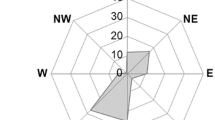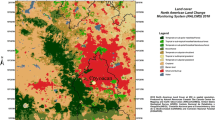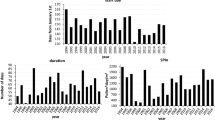Abstract
After extreme dry (wet) summers or years, pollen production of different taxa may decrease (increase) substantially. Accordingly, studying effects of current and past meteorological conditions on current pollen concentrations for different taxa have of major importance. The purpose of this study is separating the weight of current and past weather conditions influencing current pollen productions of three taxa. Two procedures, namely multiple correlations and factor analysis with special transformation are used. The 11-year (1997–2007) data sets include daily pollen counts of Ambrosia (ragweed), Poaceae (grasses) and Populus (poplar), as well as daily values of four climate variables (temperature, relative humidity, global solar flux and precipitation). Multiple correlations of daily pollen counts with simultaneous values of daily meteorological variables do not show annual course for Ambrosia, but do show definite trends for Populus and Poaceae. Results received using the two methods revealed characteristic similarities. For all the three taxa, the continental rainfall peak and additional local showers in the growing season can strengthen the weight of the current meteorological elements. However, due to the precipitation, big amount of water can be stored in the soil contributing to the effect of the past climate elements during dry periods. Higher climate sensitivity (especially water sensitivity) of the herbaceous taxa (Ambrosia and Poaceae) can be definitely established compared to the arboreal Populus. Separation of the weight of the current and past weather conditions for different taxa involves practical importance both for health care and agricultural production.





Similar content being viewed by others
References
Aboulaich N, Achmakh L, Bouziane H, Trigo MM, Recio M, Kadiri M, Cabezudo B, Riadi H, Kazzaz M (2013) Effect of meteorological parameters on Poaceae pollen in the atmosphere of Tetouan (NW Morocco). Int J Biometeorol 57(2):197–205
Akaike H (1974) A new look at the statistical model identification. IEEE Trans Autom Control 19(6):716–723
Bartková-Ščevková J (2003) The influence of temperature, relative humidity and rainfall on the occurrence of pollen allergens (Betula, Poaceae, Ambrosia artemisiifolia) in the atmosphere of Bratislava (Slovakia). Int J Biometeorol 48(1):1–5
Béres I, Novák R, Hoffmanné Pathy, Zs., Kazinczi, G. (2005). Az ürömlevelű parlagfű (Ambrosia artemisiifolia L.) elterjedése, morfológiája, biológiája, jelentősége és a védekezés lehetőségei. [Distribution, morphology, biology and importance of common ragweed (Ambrosia artemisiifolia L.) and protection facilities.] Gyomnövények, Gyomirtás, 6, 1 − 48. (in Hungarian)
Bocking C, Renz H, Pfefferle PI (2012) Prevalence and socio-economic relevance of allergies in Germany. Bundesgesundheitsblatt-Gesundheitsforschung-Gesundheitsschutz 55(3):303–307
Chuine I (2000) A unified model for budburst of trees. J Theor Biol 207:337–347
D’Amato G, Baena-Cagnani CE, Cecchi L, Annesi-Maesano I, Nunes C, Ansotegui I, et al. (2013) Climate change, air pollution and extreme events leading to increasing prevalence of allergic respiratory diseases. Multidisciplinary Respiratory Medicine, Vol. 8, Article No. 12
Deák JÁ (2010) Csongrád megye kistájainak élőhelymintázata és tájökológiai szempontú értékelése. (Habitat-pattern and landscape ecological evaluation of the microregions of Csongrád county.) PhD Dissertation, University of Szeged, 125 p. (in Hungarian)
Deák JÁ, Makra L, Matyasovszky I, Csépe Z, Muladi B (2013) Climate sensitivity of allergenic taxa in Central Europe associated with new climate change-related forces. Sci Total Environ 442:36–47
de Marco R, Cappa V, Accordini S, Rava M, Antonicelli L, Bortolami O et al (2012) Trends in the prevalence of asthma and allergic rhinitis in Italy between 1991 and 2010. Eur Respir J 39(4):883–892
Draper N, Smith H (1981) Applied regression analysis, 2nd edn. Wiley, New York
Emberlin J, Norris-Hill J (1991) Annual, daily and diurnal variation of Urticaceae pollen in North-Central London. Aerobiologia 7(1):49–56
Emberlin J, Mullins J, Corden J, Millington W, Brooke M, Savage M et al (1997) The trend to earlier birch pollen seasons in the U.K.: a biotic response to changes in weather conditions? Grana 36(1):29–33
Emberlin J, Smith M, Close R, Adams-Groom B (2007) Changes in the pollen seasons of the early flowering trees Alnus spp. and Corylus spp. in Worcester, United Kingdom, 1996–2005. Int J Biometeorol 51(3):181–191
Fischer G, Roppert J (1965) Ein Verfahren der Transformationsanalyse faktorenanalytischer Ergebnisse. In: Lineare Strukturen in Mathematik und Statistik unter besonderer Berücksichtigung der Faktoren- und Transformationsanalyse. Arbeiten aus dem Institut für höhere Studien und wissenschaftliche Forschung. Wien Verlag Physica, Wien-Würzburg, 1. (in German)
Galán C, Fuillerat MJ, Comtois P, Domínguez-Vilches E (1998) Bioclimatic factors affecting daily Cupressaceae flowering in southwest Spain. Int J Biometeorol 41(3):95–100
Galán C, Alcázar P, Cariňanos P, Garcia H, Domínguez-Vilches E (2000) Meteorological factors affecting daily Urticaceae pollen counts in southwest Spain. Int J Biometeorol 43(4):191–195
Galán C, Cariňanos P, García-Mozo H, Alcázar P, Domínguez-Vilches E (2001) Model for forecasting Olea europaea L. airborne pollen in South-West Andalusia, Spain. Int J Biometeorol 45(2):59–63
Gehrig R (2006) The influence of the hot and dry summer 2003 on the pollen season in Switzerland. Aerobiologia 22(1):27–34
Giner MM, García JSC, Sellés JG (1999) Aerobiology of Artemisia airborne pollen in Murcia (SE Spain) and its relationship with weather variables: annual and intradiurnal variations for three different species. Wind vectors as a tool in determining pollen origin. Int J Biometeorol 43(2):51–63
Hänninen H, Kellomäki S, Laitinen K, Pajari B, Repo T (1993) Effect of increased winter temperature on the onset of height growth of Scots pine: a field test of a phenological model. Silva Fennica 27(4):251–257
Harsányi E (2009) Parlagfű és allergia. (Ragweed and allergy.). Növényvédelem 45(8):454–458 (in Hungarian)
Hirst JM (1952) An automatic volumetric spore trap. Ann Appl Biol 39(2):257–265
Haraszty Á (ed.) (2004) Növényszervezettan és növényélettan. (Plant Anatomy and Plant Physiology.) Budapest: Nemzeti Tankönyvkiadó. (in Hungarian)
Horváth F, Dobolyi ZK, Morschhauser T, Lőkös L, Karas L, Szerdahelyi T (1995) Flóra adatbázis. (Flora database.) 1.2. Vácrátót: MTA-ÖBKI. (in Hungarian)
Jahn W, Vahle H (1968) Die Faktoranalyse und ihre Anwendung. Verlag die Wirtschaft, Berlin (in German)
Jolliffe IT (1990) Principal component analysis: a beginner’s guide—I. Introduction and application Weather 45(10):375–382
Jolliffe IT (1993) Principal components analysis: a beginner’s guide—II. Pitfalls, myths and extensions. Weather 48(8):246–253
Jones AM, Harrison RM (2004) The effects of meteorological factors on atmospheric bioaerosol concentrations—a review. Sci Total Environ 326:151–180
Kadocsa E, Juhász M (2002) Study of airborne pollen composition and allergen spectrum of hay fever patients in South Hungary (1990–1999). Aerobiologia 18(3–4):203–209
Kapyla M (1984) Diurnal variation of tree pollen in the air in Finland. Grana 23(3):167–176
Kasprzyk I (2008) Non-native Ambrosia pollen in the atmosphere of Rzeszow (SE Poland): evaluation of the effect of weather conditions on daily concentrations and starting dates of the pollen season. Int J Biometeorol 52(5):341–351
Kasprzyk I, Walanus A (2010) Description of the main Poaceae pollen season using bi-Gaussian curves, and forecasting methods for the start and peak dates for this type of season in Rzeszow and Ostrowiec Sw. (SE Poland). J Environ Monit 12(4):906–916
Kazinczi G, Béres I, Pathy Z, Novák R (2008) Common ragweed (Ambrosia artemisiifolia): a review with special regards to the results in Hungary: II. Importance and harmful effect, allergy, habitat, allelopathy and beneficial characteristics. Herbologia 9(1):94–118
Király G (ed.) (2009) Új magyar füvészkönyv I-II. Magyarország hajtásos növényei. Határozókulcsok. (New Hungarian grass book I-II. Shooted plants of Hungary. Adverbs keys.) Jósvafő: Aggteleki Nemzeti Park Igazgatóság. (in Hungarian)
Köppen W (1931) Grundriss Der Klimakunde. Walter De Gruyter & Co., Berlin (in German)
Laaidi M (2001) Forecasting the start of the pollen season of Poaceae: evaluation of some methods based on meteorological factors. Int J Biometeorol 45(1):1–7
Láng F (ed.) (1998). Növényélettan. A növényi anyagcsere. (Plant physiology. Metabolism of plants.) Budapest: ELTE Eötvös Kiadó. (in Hungarian)
Langen U, Schmitz R, Steppuhn H (2013) Prevalence of allergic diseases in Germany. Results of the German Health Interview and Examination Survey for Adults (DEGS1). Bundesgesundheitsblatt-Gesundheitsforschung-Gesundheitsschutz 56:698–706
Linderholm HW (2006) Growing season changes in the last century. Agric For Meteorol 37(1–2):1–14
Liu PWG (2009) Simulation of the daily average PM10 concentrations at Ta-Liao with Box-Jenkins time series models and multivariate analysis. Atmos Environ 43(13):2104–2113
Makra L, Sánta T, Matyasovszky I, Damialis A, Karatzas K, Bergmann KC et al (2010) Airborne pollen in three European cities: detection of atmospheric circulation pathways by applying three-dimensional clustering of backward trajectories. J Geophys Res Atmos 115:D24220. doi:10.1029/2010JD014743
Makra L, Matyasovszky I (2011) Assessment of the daily ragweed pollen concentration with previous-day meteorological variables using regression and quantile regression analysis for Szeged, Hungary. Aerobiologia 27(3):247–259
Makra L, Matyasovszky I, Deák JÁ (2011) Trends in the characteristics of allergenic pollen circulation in Central Europe based on the example of Szeged, Hungary. Atmos Environ 45(33):6010–6018
Makra L, Matyasovszky I, Páldy A, Deák JÁ (2012) The influence of extreme high and low temperatures and precipitation totals on pollen seasons of Ambrosia, Poaceae and Populus in Szeged, southern Hungary. Grana 51(3):215–227
Makra L, Csépe Z, Matyasovszky I, Deák ÁJ, Pál-Molnár E, Tusnády G (2014) Interdiurnal variability of Artemisia, Betula and Poaceae pollen counts and their association with meteorological parameters. Carpathian J Earth Environ Sci 9(3):207–220
Matyasovszky I, Makra L, Csépe Z (2012) Associations between weather conditions and ragweed pollen variations in Szeged, Hungary. Arch Ind Hyg Toxicol (Arhiv Za Higijenu Rada I Toksikologiju) 63(3):311–320
McGregor GR, Bamzelis D (1995) Synoptic typing and its application to the investigation of weather—air pollution relationships, Birmingham, United Kingdom. Theor Appl Climatol 51(4):223–236
Ong EK, Taylor PE, Knox RB (1997) Forecasting the onset of the grass pollen season in Melbourne (Australia). Aerobiology 13(1):43–48
Páldy A, Bobvos J, Magyar D, Nékám K, Bitay Z, Csajbók V et al (2010) Parlagfűallergia. A parlagfű pollinózis – a poliszenzitizáltság kezdete? (Ragweed allergy. Ragweed pollinosis—the start of the pollen sensitivity?). Egészségtudomány 54(4):47–55 (in Hungarian)
Prtenjak MT, Srnec L, Peternel R, Madzarevic V, Hrga I, Stjepanovic B (2012) Atmospheric conditions during high ragweed pollen concentrations in Zagreb, Croatia. Int J Biometeorol 56(6):1145–1158
Sabariego S, Pérez-Badia R, Bouso V, Gutiérrez M (2011) Poaceae pollen in the atmosphere of Aranjuez, Madrid and Toledo (central Spain). Aerobiologia 27(3):221–228
Sánchez Mesa JA, Galán C, Hervás C (2005) The use of discriminant analysis and neural networks to forecast the severity of the Poaceae pollen season in a region with a typical Mediterranean climate. Int J Biometeorol 49(6):355–362
Ščevková J, Dušička J, Chrenová J, Mičieta K (2010) Annual pollen spectrum variations in the air of Bratislava (Slovakia): years 2002–2009. Aerobiologia 26(4):277–287
Sindosi OA, Katsoulis BD, Bartzokas A (2003) An objective definition of air mass types affecting Athens, Greece; the corresponding atmospheric pressure patterns and air pollution levels. Environ Technol 24(8):947–962
Štefanič E, Kovačevič V, Lazanin Ž (2005) Airborne ragweed pollen concentration in north-eastern Croatia and its relationship with meteorological parameters. Ann Agric Environ Med 12(1):75–79
Spieksma FTM, Emberlin JC, Hjelmroos M, Jäger S, Leuschner RM (1995) Atmospheric birch (Betula) pollen in Europe—trends and fluctuations in annual quantities and the starting dates of the seasons. Grana 34(1):51–57
Stefanovits P (1999) A talajok osztályzása. Főtípusok, típusok és altípusok. (Classiciation of soils. Main types, types and sub-types.) In: P. Stefanovits, Gy. Filep, Gy. Füleky (Eds.), Talajtan (Soil science) (pp. 239–314.) Budapest: Mezőgazda Kiadó. (in Hungarian)
Szigetvári Cs, Benkő ZsR (2004) Ürömlevelű parlagfű (Ambrosia artemisiifolia). pp. 337-370. In: Mihály B, Botta-Dukát Z (eds.) Özönnövények − Biológiai Inváziók Magyarországon. (Invasive Plants – Biological Invasions in Hungary.) A KvVM Természetvédelmi Hivatalának Tanulmánykötetei, (Essays of the Conservation Agency of the Ministry of Environment and Water), 9. TermészetBúvár Alapítvány Kiadó, Budapest, 408 p. ISBN: 9638610751 (in Hungarian)
Veriankaitè L, Šaulienè I, Bukantis, A. (2011) Evaluation of meteorological parameters influence upon pollen spread in the atmosphere. J Enviro Eng Landsc Manag 19(1), 5–11. www. pollenindex.hu http://www.eea.europa.eu/publications/COR0-landcover
Acknowledgments
The authors would like to thank Gábor Motika (Environmental Conservancy Inspectorate, Szeged, Hungary) for providing the meteorological data of Szeged and Miklós Juhász (University of Szeged) for providing the daily pollen concentration data of Szeged. This research was supported by the European Union and the State of Hungary, cofinanced by the European Social Fund in the framework of TÁMOP 4.2.4. A/2-11-1-2012-0001 ‘National Excellence Program’.
Author information
Authors and Affiliations
Corresponding author
Rights and permissions
About this article
Cite this article
Matyasovszky, I., Makra, L., Csépe, Z. et al. Plants remember past weather: a study for atmospheric pollen concentrations of Ambrosia, Poaceae and Populus . Theor Appl Climatol 122, 181–193 (2015). https://doi.org/10.1007/s00704-014-1280-2
Received:
Accepted:
Published:
Issue Date:
DOI: https://doi.org/10.1007/s00704-014-1280-2




